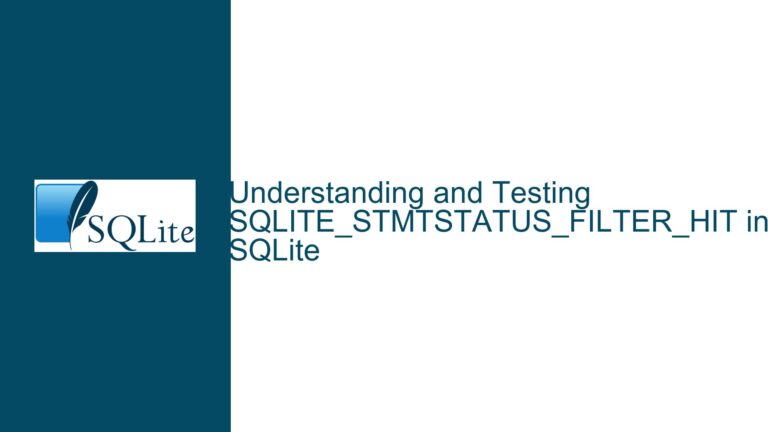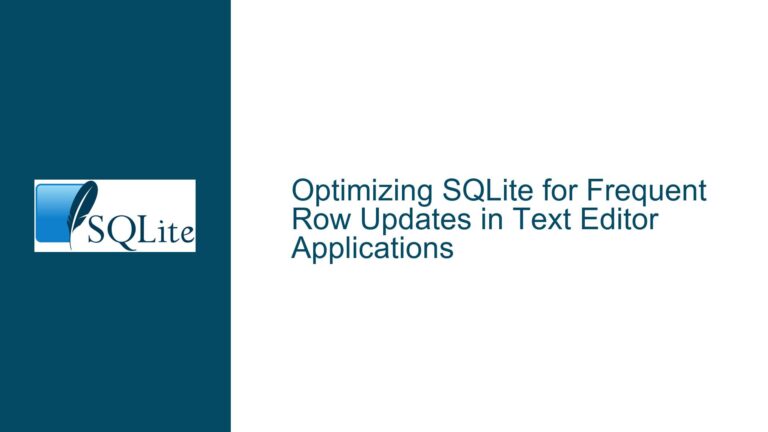SQLite Virtual Table bestIndex Callback LIMIT Constraint Issue
Issue Overview: Missing LIMIT Constraint in bestIndex Callback for Vector Search Queries
When implementing a virtual table in SQLite for vector search functionality, developers often encounter a specific issue with the bestIndex callback. The problem arises when attempting to execute queries that involve both a custom function (e.g., vector_nearby) and a LIMIT clause. The bestIndex callback is designed to receive constraints from the SQL query, which are then used to optimize the query execution. However, in certain versions of SQLite (prior to 3.41), the LIMIT constraint is not passed to the bestIndex callback when used in conjunction with a custom function like vector_nearby.
The virtual table in question is designed to support K-nearest neighbors (KNN) queries, where the goal is to find the closest vectors to a given input vector. The table typically has two columns: docid and vector. The query pattern looks like this: SELECT docid FROM vtab WHERE vector_nearby(vector, ?) LIMIT 10. The intention is to retrieve the IDs of the 10 nearest vectors to the one provided as a parameter. For this to work correctly, the bestIndex callback must receive both the vector_nearby constraint and the LIMIT constraint. However, in SQLite versions prior to 3.41, the LIMIT constraint is not passed to the bestIndex callback when the query involves a custom function.
This behavior is inconsistent with how SQLite handles other types of constraints. For example, if the query uses an equality condition (WHERE vector = ? LIMIT 10), the bestIndex callback receives both the SQLITE_INDEX_CONSTRAINT_EQ and SQLITE_INDEX_CONSTRAINT_LIMIT constraints. This inconsistency suggests a bug in SQLite’s handling of custom functions in the context of virtual tables.
Possible Causes: SQLite Version-Specific Bug and Custom Function Handling
The root cause of this issue lies in a bug in SQLite versions prior to 3.41. Specifically, the bug affects how the bestIndex callback processes constraints when a custom function is involved in the query. The bestIndex callback is responsible for receiving and processing constraints from the SQL query, which are then used to optimize query execution. However, in versions prior to 3.41, the LIMIT constraint is not passed to the bestIndex callback when the query involves a custom function like vector_nearby.
This bug is particularly problematic for virtual tables that implement custom search functionality, such as vector search. In such cases, the LIMIT constraint is crucial for determining how many results to return. Without this constraint, the virtual table implementation cannot correctly determine the number of nearest neighbors to retrieve, leading to incorrect or incomplete query results.
The issue is further compounded by the fact that the LIMIT constraint is correctly passed to the bestIndex callback when the query involves a standard comparison operator (e.g., =). This inconsistency suggests that the bug is specific to the handling of custom functions in the context of virtual tables.
Another potential cause of the issue is the way custom functions are registered and recognized by SQLite. In the case of the vector_nearby function, the developer has implemented the xFindFunction callback to recognize the function and return SQLITE_INDEX_CONSTRAINT_FUNCTION. While this approach works for recognizing the custom function, it does not address the issue of the missing LIMIT constraint. This suggests that the problem is not with the custom function itself, but rather with how SQLite processes constraints in the context of virtual tables.
Troubleshooting Steps, Solutions & Fixes: Upgrading SQLite and Alternative Query Syntax
The most straightforward solution to this issue is to upgrade to SQLite version 3.41 or later. As noted in the forum discussion, this bug was fixed in SQLite version 3.41. Upgrading to this version or later will ensure that the LIMIT constraint is correctly passed to the bestIndex callback, even when the query involves a custom function like vector_nearby. This solution is ideal for developers who have control over the SQLite version used in their projects and can easily upgrade to a newer version.
However, in some cases, upgrading SQLite may not be feasible. For example, if the project is deployed in an environment where the SQLite version cannot be easily changed, or if the project is distributed as a loadable extension that needs to be compatible with older versions of SQLite. In such cases, an alternative solution is to modify the query syntax to work around the issue.
One such workaround involves using a custom function to encapsulate both the search vector and the limit value. For example, instead of writing the query as SELECT docid FROM vtab WHERE vector_nearby(vector, ?) LIMIT 10, the query can be rewritten as SELECT docid FROM vtab WHERE vector_nearby(vector, nearby_params(?, 10)). In this case, nearby_params is a custom function that takes two parameters: the search vector and the limit value. The vector_nearby function can then extract both the search vector and the limit value from the nearby_params function, allowing the virtual table implementation to correctly determine the number of nearest neighbors to retrieve.
This workaround is not as intuitive as using the LIMIT clause directly, but it does provide a way to achieve the desired functionality in environments where upgrading SQLite is not an option. Additionally, this approach can serve as a temporary solution while waiting for the SQLite version to be upgraded.
Another potential solution is to use a table-valued function instead of a virtual table. Table-valued functions in SQLite allow a function to return a set of rows, which can then be queried as though they were a table. In the context of vector search, a table-valued function could be used to return the nearest neighbors to a given vector. However, this approach has its own challenges, particularly in terms of how the function would access the vectors to search. The function would need to know the name of the vector table, which would have to be passed as a parameter, making the query syntax more cumbersome.
In conclusion, the issue of the missing LIMIT constraint in the bestIndex callback for virtual tables in SQLite can be addressed by upgrading to SQLite version 3.41 or later. For environments where upgrading is not feasible, alternative query syntax using custom functions can provide a workaround. While these solutions may not be as elegant as using the LIMIT clause directly, they do allow developers to achieve the desired functionality in a wide range of scenarios.






